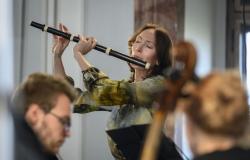They are almost invisible and therefore more and more popular. Straightening their teeth using foil or so-called “invisible” braces is also done by people who would otherwise be put off by the idea of a classic fixed appliance.
On the other hand, many may be put off by the price for a change. Those interested will pay approximately 70 to 120 thousand crowns for them.
The overwhelming majority of orthodontists buy material from foreign companies. It is precisely the prices of the suppliers that have the most significant effect on the amount that the Czech customer has to pay as a result.
“So far, the insurance company does not pay for foil devices to anyone. With them, we are so-called providers – we buy the overwhelming majority of them from American companies, which simply have a given price,” points out the chairman of the Czech Orthodontic Society (ČOS) Ivo Marek.
“For example, we pay a purchase price of approximately 41,000 crowns without VAT for extended foil braces from a large American manufacturer,” adds orthodontist Lucie Žáková, who works at the Smart care clinic in Prague.
“The amount the patient pays for the braces is the amount for the entire two years of treatment. You thereby pay for the work of the entire team during your visits over the course of two years,” he adds.
According to her, specific clinics can therefore influence the price of braces only if they reduce their labor costs. “They would have fewer people, but they would be able to treat fewer patients and the waiting times would be even longer,” he outlines.
The prices of braces vary greatly depending on their type, the severity of the patient’s defect, and the specific surgery.
A cheaper option is the so-called fixed device. These are classic locking braces that patients must wear continuously. The cheapest ones can be bought in the Czech Republic for approximately 25,000, but often the price rises to twice that.
In most cases, insurance companies do not contribute anything to braces, nor do they pay for the doctor’s work. All costs are thus borne by the patient.
Exceptions are made for people with severe dental developmental defects and children and adolescents under 21 years of age. With them, the dentist’s work is usually paid for, insurance companies also contribute to the material (only in the case of fixed braces). However, the contribution is often only a fraction of the total amount.
Disagreements between dentists and orthodontists
In the past, the president of the Czech Stomatological Chamber (ČSK) Roman Šmucler commented on the high prices of orthodontic care.
“Orthodontics is the most expensive in the world here. Fortunately, the situation is different in other dental fields. But even the services of orthodontists in neighboring Germany are significantly cheaper than in the Czech Republic,” he said for the Zdravé Zprávy server.
In a statement for Seznam Zpravy, he distanced himself from these statements. “The prices are not high, they are just normal,” he said, among other things.
However, some orthodontists criticize his earlier statements about expensive care. “Orthodontic care in the Czech Republic is the cheapest, not the most expensive, in Central and Western Europe. It’s completely wrong information, which the president constantly omits for some unknown reason,” responds the head of orthodontists, Ivo Marek.
It also contradicts Šmucler’s earlier words about people going to neighboring countries for braces. “Fixed treatment in Germany costs a patient seven to eight thousand euros, here it comes to four to five thousand euros,” he points out.
Orthodontist Žáková also confirms his words. “It is not true that the Czech Republic is among the most expensive countries in terms of the price of braces,” he emphasizes.
According to her, an interested party will pay approximately six thousand euros (approximately 150 thousand crowns) for fixed braces in Germany. Four thousand euros (approximately 100 thousand crowns) for invisible braces.
Invisible braces, which are perceived as a more luxurious option, are paradoxically cheaper in Germany than the classic braces. “Fixed braces require a lot more work than invisible braces. The purchase of material is cheaper for fixed ones, but the work is many times more demanding. And the one in Germany is more expensive,” explains Žáková.
According to her, other factors are also reflected in the final price. “Each orthodontist must have his own team to be able to accommodate a wide range of people interested in treatment. Work in the Czech Republic is very highly taxed, so labor costs are one of the biggest items, alongside materials, tools and other inputs,” he explains.
Lack of specialists
A persistent problem is the lack of specialists and the associated unavailability of care in some parts of the Czech Republic. The worst situation is in the Liberecký Region, where, according to ČSK data from 2022, there are only six orthodontists. There are about 70,000 inhabitants per specialist.
“It’s exactly the same as with dentists – they stay in the big cities where they graduated. This is the case for more than half of Prague’s orthodontists,” states Marek.
A dentist who wants to specialize must complete a five-year study of dentistry and then another three-year additional study of orthodontics at an accredited workplace. This means that their number is de facto regulated.
According to ČSK data, in 2022 we had 337 orthodontists in the Czech Republic. According to Mark, this number is sufficient. Insurance companies could solve the problem with their distribution by regulating contracts for doctors in big cities.
“The Czech Republic has the best developed system for the number of doctors and patients in the last 30 years. We have 28,000 citizens per orthodontist, which is above average in Europe. Those numbers range from roughly 20 to 100 thousand inhabitants,” he calculates.
“In addition, we train approximately 12 to 15 new orthodontists each year, exactly replacing those who are retiring. The system works perfectly,” he says.
However, the President of the Czech Republic sees a problem in the state-regulated number of orthodontists. “The number of orthodontists has not increased much since socialism. But the interest in orthodontics is manifold,” thinks Šmucler.
Braces even without specialization?
According to Šmucler, the system should change. “There are therefore two ways. Either you let other doctors do the braces, or the number of specialists must increase,” he claims.
“In America, every dentist who takes a course does braces. I think that a dentist who has a university is able to learn it in half a year. Everyone here says that they have to learn it only in the state hospital,” he adds.
According to him, orthodontists could be trained in private facilities or under the dental chamber.
However, the chairman of orthodontists does not agree with him. According to him, if any dentist could perform orthodontic procedures, the quality of care would decrease.
Žáková also agrees with this. “When you study dentistry, you have no idea about orthodontics. It’s not common in any developed country, braces are always made by a specialist,” he comments.






